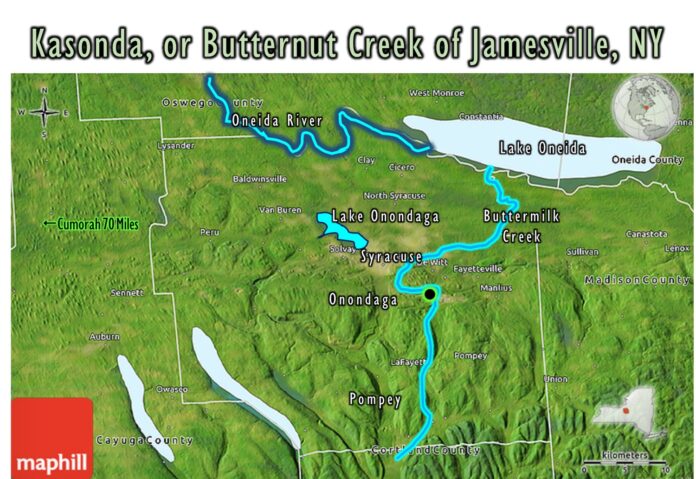I love the Iroquois Nation and I especially love the Onondaga Tribe within that nation of whom Zelph was a member. Zelph’s prophet during the time frame of the Book of Mormon was Onondagus according to the Joseph Smith Papers here. I am guessing Onandagus would have lived about 280 AD, considering the dating of the Zelph Mound in Valley City, Illinois. Blog Here I have a great love of the Prophet Joseph Smith and of Zelph, I call the Onondaga Nation, Joseph Smith’s Lamanites. You can see more on my personal website at worksofjoseph.com
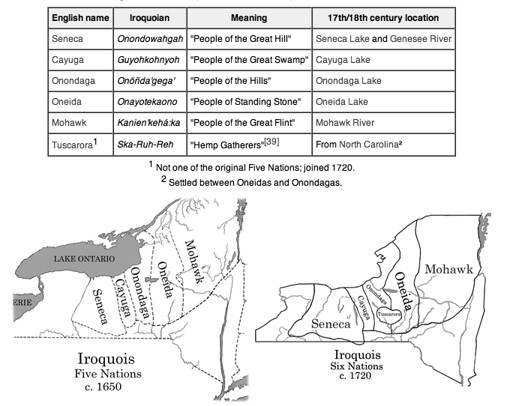 Joseph Smith Knew the Iroquois
Joseph Smith Knew the Iroquois
“Contrary, then, to widespread assumptions during Joseph Smith’s lifetime that the Onondaga migrated to the New York region, it becomes clear that they originated here as a small, narrowly localized amalgamation of a few villages near Onondaga Lake, during the century before Columbus’ discovery of America” Beauchamp’s Aboriginal Place Names of New York;
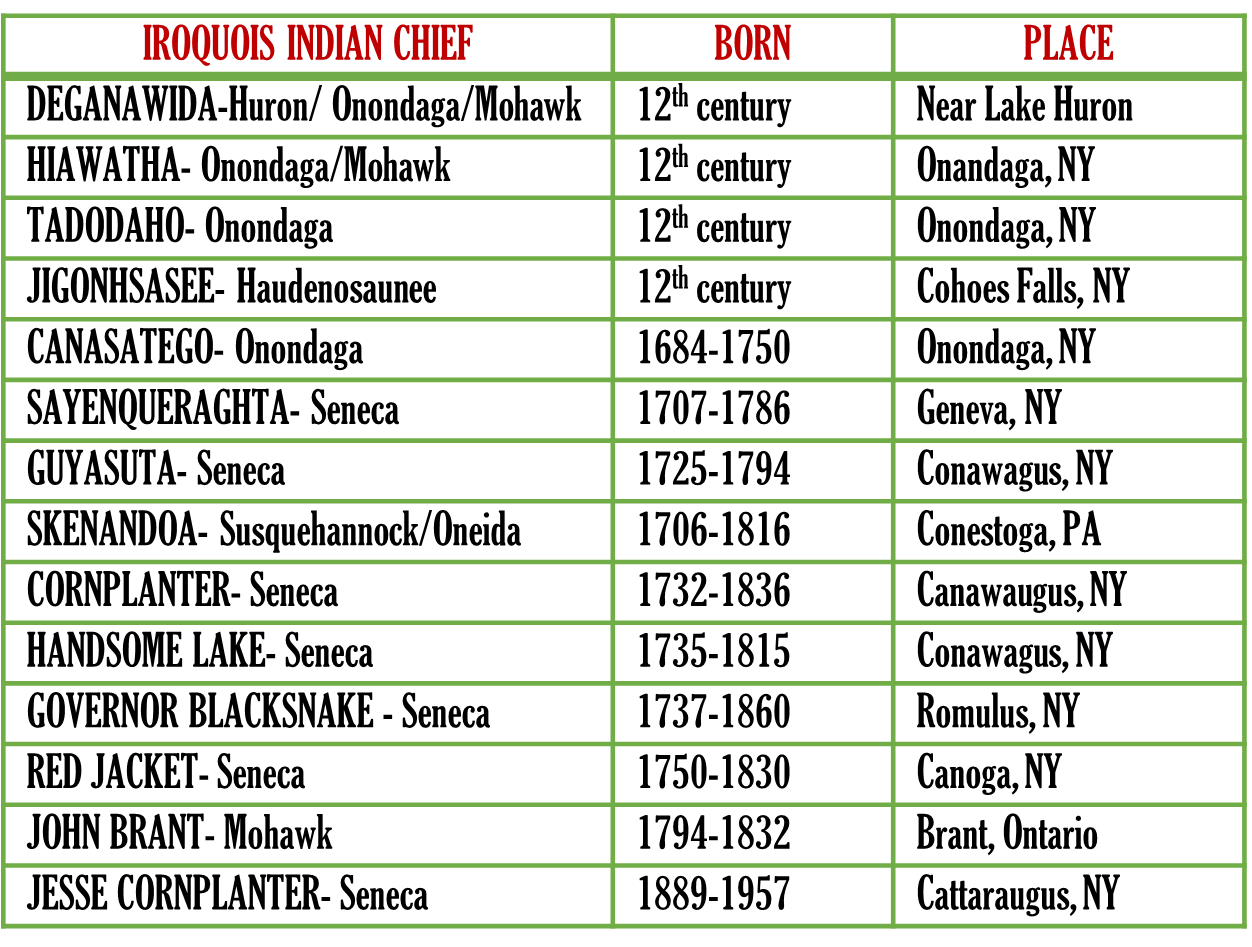
“Onondaga was a name that Joseph would have heard frequently in the Indian lore which B. H. Roberts felt must have influenced Joseph during his early days in Palmyra… Indeed, in order to reach Palmyra in company with Lucy Mack Smith and his siblings when they emigrated from Vermont, Joseph had to traverse the important township of Onondaga, through which the original Genesee and Seneca Turnpikes still run today…
Ganargua Creek (Mud Creek) was a primary stopover point for the Iroquois on their trade routes. Joseph Smith also had an interest in the creek after hearing a speech from Seneca Indian Chief Red Jacket at Palmyra in 1822.” Mormon Parallels: A Bibliographic Source 2014 Rick Grunder
Buried the Weapons of War
The Onondaga at the great white pine tree in Syracuse NY on the shores of Onondaga Lake is where the message of peace was planted and the hatchets were buried. Similarly, the Lamanites, did the same.
“And thus we see that, when these Lamanites were brought to and to know the truth, they were , and would suffer even unto death rather than commit sin; and thus we see that they buried their weapons of peace, or they buried the weapons of war, for peace.” Alma 24:19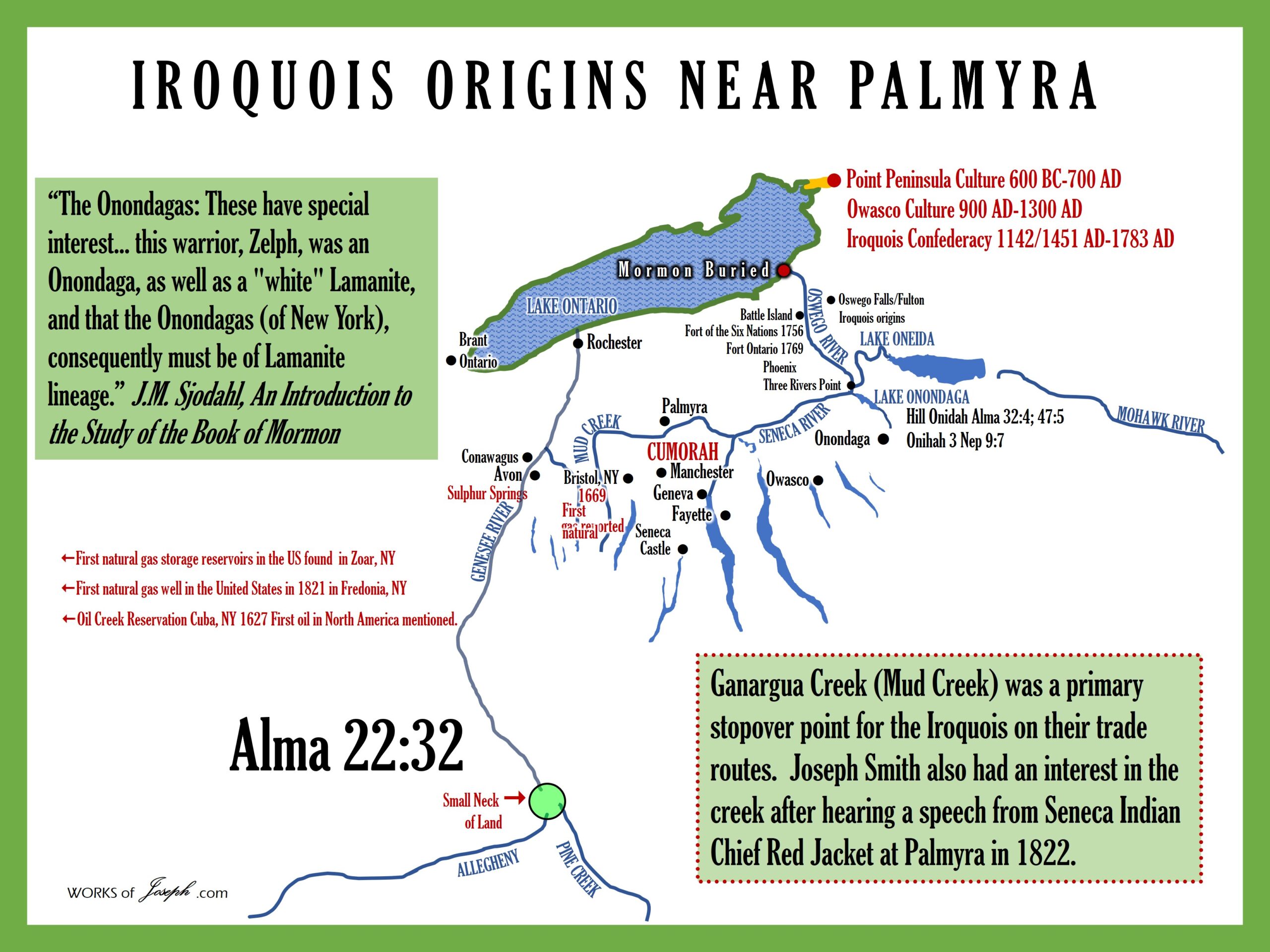
The Onondagas
“These have special interest… this warrior, Zelph, was an Onondaga, as well as a “white” Lamanite, and that the Onondagas (of New York), consequently must be of Lamanite lineage.” J.M. Sjodahl, An Introduction to the Study of the Book of Mormon
“Many historians believe that Iroquoian ideas of federalism, and balance of power directly influenced the US system of government. Benjamin Franklin admired native American government structures. In 1744, Canassatego advocated in Washington the federal union of the American colonies…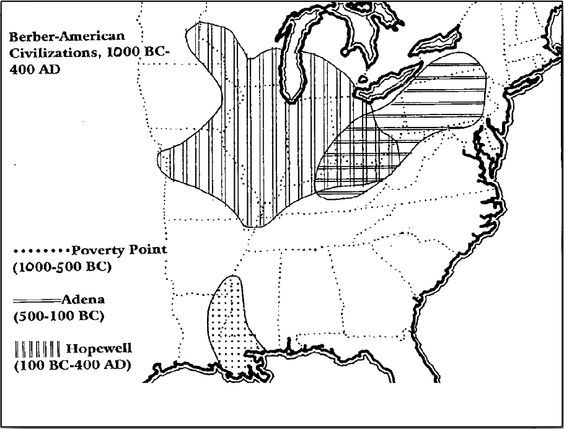
Onondaga was, from the remotest times, the seat of the Iroquois government. Granting credence to the account of their own origin, on the high grounds or falls of the Oswego, (East of Fulton NY) they had not proceeded far up the course of the widely gathered waters of this stream, when a portion of them planted their wigwams in this fertile region. Whatever was the cause of their migrating from their primary council fire, nothing was more natural than that, by pursuing this stream upward, they should separate into independent tribes, and by further tracing out its far spread forks, gradually expand themselves, as they were found by the discoverers and first settlers, over the entire area of western New-York.
On reaching the grand junction of Three River Point (Phoenix, NY), a part went up the Seneca river, who subsequently dividing, formed the Senecas and Cayugas. The bands who took the eastern fork, or Oneida river, pushed forward over the Deowainsta, or Rome summit, into the first large stream, flowing east, and became the Mohawks. The central or Onondaga fork was chosen by the portion who, from the hill country (Onondaga) they first located in, took this name; and from them, the Oneidas, pursuing in fact the track of the Mohawks, were an off-shoot…
The idea of a confederation was, it is believed, an old one with this people, for the very oldest traditions speak of something of this kind, among the lake and St. Lawrence tribes of older days. When the present league was formed, on the banks of the Onondaga lake, this central tribe had manifestly greatly increased in strength, and distinguished itself in arms, and feats of hunting and daring against giants and monsters… Most distinguished, however, above all others, east or west, was a leader of great courage, wisdom and address, called Atotarho…
A singular tradition may be here added. It is said that the XIIIth Atotarho reigned at Onondaga when America was discovered” (1414 AD) Aboriginal History, Antiquities and General Ethnology of Western New-York by Henry R. Schoolcraft
Peacemaker
Some say it was a thousand years ago. Some say that it was two thousand years when there was a dark period in the history of The People. The Mohawk, Oneida, Onondaga, Cayuga and Seneca Nations were at war with one another. It was a terrible time of cruelty, bloodshed and mourning. But then a Huron man, referred to as the Peacemaker, canoed from the western shore of Lake Ontario. He brought with him a message of peace and unity.
The first individual to accept his message of peace was a Seneca woman named Jigonsaseh. Because it was a woman who was the first individual to accept his message of peace, the Peacemaker gave women an important role in the new confederacy that was to be formed. Jigonsaseh became known as “The Mother of Nations.” Source
“The Mohawk, Oneida, Onondaga, Cayuga and Seneca people had been warring against each other. There was great bloodshed and death surrounding us. These people of the five nations had forgotten their ways and their actions saddened the Creator. The Creator decided to send a messenger to the people so that the five nations could live in peace. The messenger is referred to as the Peacemaker…
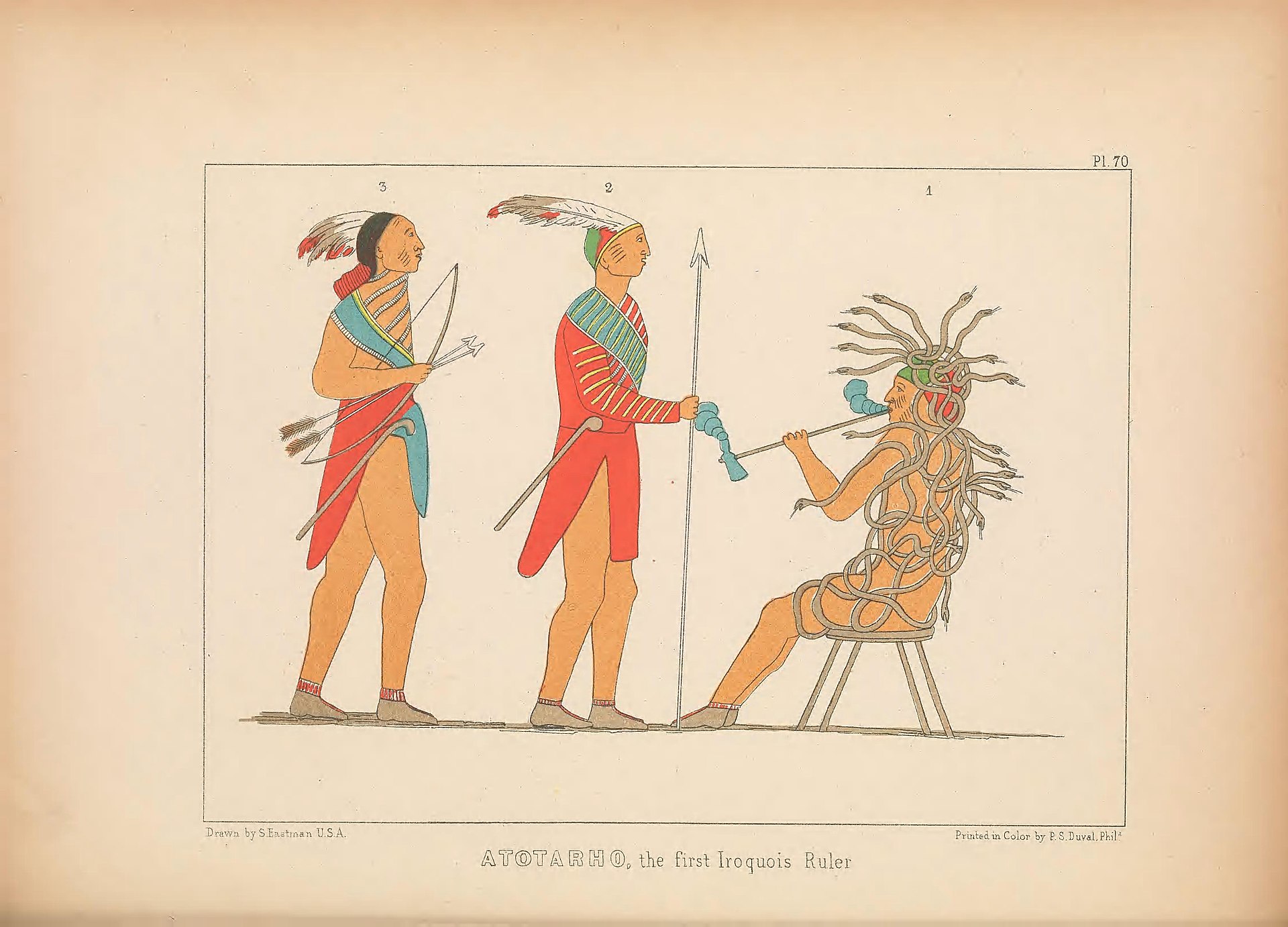
Once all four nations agreed to join in the peace, all that remained was the Onondaga. Peacemaker, Hiawatha, and the leaders from the other Nations were ready to confront Tadodaho again. Tadodaho tried his sorcerous ways to stop them as they traveled across Onondaga Lake. But the message of peace was unstoppable.
The Peacemaker then offered to Tadodaho a very special duty in this plan of peace. Tadodaho would preside over the Grand Council of 50 chiefs. That he would have the responsibility to make sure that decisions were made with a good mind and were aligned not only for today, but for the generations not yet born. It is at this time when Tadodaho agreed to live in a peaceful way as they “combed the snakes” from Tadodaho’s hair.
The Peacemaker then symbolized this union of peace by uprooting a great white pine tree. All 50 leaders and threw their weapons of hatred, jealousy, anger, and war into the hole and a mighty stream washed it away. As they replanted the tree, the Peacemaker placed an eagle on top of the Tree of Peace. The eagle is there to use his eyesight to look out far and to warn the Haudenosaunee, the People of the Longhouse, of any dangers on the horizon to this great peace.
A wampum belt was made to record the event. It is called the Hiawatha Belt. The belt is made of purple shells with five symbols across the center. Hiawatha Belt begins with a symbol for the Mohawk people, next the Oneida, in the center is the Tree of Peace and the Onondaga, next is the Cayuga and the final symbol is the Seneca people. We were now all united in peace and have remained that way for countless centuries.” Source
Handsome Lake Seneca Prophet
“How America Was Discovered is a story told by Handsome Lake (Seneca Prophet), and documented by Arthur C. Parker, about a young minister who meets the one he perceives to be the Lord, who then asks him to go to a new land and bring with him cards, money, a fiddle, whiskey, and blood corruption. In return the young minister will become rich. The young minister sought out Christopher Columbus, and with the help of his crew, traveled to the Americas. They turned back to report what they had seen, which caused an immigration of people from Europe to the Americas. Along with the people came the five things that aided in destroying the natives. The end reveals that the “Lord” in the gold castle was actually the devil, and that even he knew what he had caused was wrong.” Rudes, B. Tuscarora English Dictionary Toronto
Pompey in Onondaga County
“Pompey in Onondaga County, a town covering upwards of five hundred acres must have contained a population greatly transcending all our ideas of credibility . . . This town was on elevated ground, . . . and was well calculated for defense. . . . There are three old forts distant about eight miles from each other, and forming a triangle which encloses the town; . . . and they were, in all probability, erected to cover the town and to protect the inhabitants from the attacks of an enemy. . . . On the line of the north side, the town was probably stormed. There are graves on each side close to the precipice; sometimes five or six persons were thrown promiscuously into the same grave. If the invaders had been repulsed, the inhabitants would have interred the killed in the usual places; but from the circumstance of there being graves near the ravine and in the village, I am induced to believe that the town was taken. (noting ‘gun barrels, axes, hoes and swords . . . all over these grounds’) The traditions of the Indians agree in some measure with the French relations. They represent that their forefathers had several bloody battles with the French…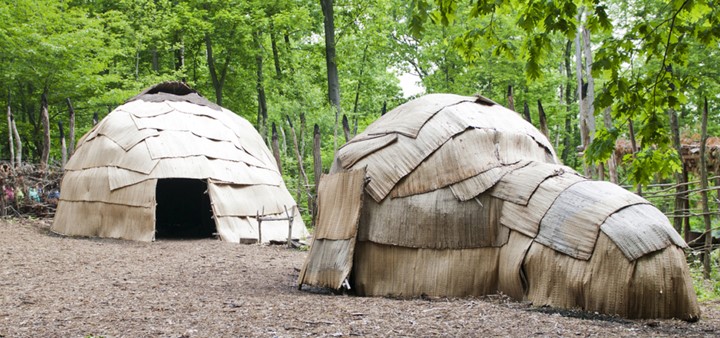
There is a hill in Pompey, which the Indians will not visit, and which they call Bloody Hill…
The old fortifications were erected previous to European intercourse. The Indians are ignorant by whom they were made; and in the wars which took place in this country, it is probable that they were occupied as strong holds by the belligerents; and it is likely that the ruins of European works of a different construction may be found… it is remarkable that our ancient forts resemble the old British and Danish. The Bloody Hill site dated by modern archaeology to ca. 1420 A.D. has been excavated carefully in modern times, yielding comparatively superior ceramic artifacts. Significantly more Native sites are now recognized in Pompey, beyond the few which [DeWitt] Clinton knew or was able to visit.” (James A. Tuck, 104-119) Mormon Parallels: A Bibliographic Source 2014 Rick Grunder page 403. Map from “Onondaga Iroquois Pre History A Study in Settlement Archaeology” James A. Tuck 1971 page 20

It has been very common amongst the many cultures of the Native Americans to utilize a previous culture of their left over ruins and develop it into its own new culture and civilization.
For example, you see the picture left of the three different cultures. The Adena lived from 1500 BC to about 300 AD, the Hopewell Culture was from 600 BC to 400 AD and the Fort Ancient culture was from 1000 to 1500 AD. They all built over each other.
The history of the Adena (Jaredites) and Hopewell (Nephites) shows they did have mounds and earthworks that covered both time periods.
I have found the beginning of the Historical Iroquois or Haudenosaunee began 1142 AD to 1797 AD. Here are some of the important treaties and agreements they entered into:
1613 Two Row Wampum or Tawagonshi Agreement (Dutch and French)
1677 Covenant Chain Treaty (English)
1784 The Treaty of Fort Stanwix between the United States and Native Americans. Rome, New York
1788 Phelps & Gorham Purchase with the Iroquois for lands in New York State east of the Genesee River
1794 Treaty of Canandaigua affirming lands rights in New York State east of the Genesee River
1797 Treaty of Big Tree with the Iroquois for lands in New York State west of the Genesee River

Ancient Site of the Onondagas in the Valley of the Kasonda, or Butternut Creek of Jamesville 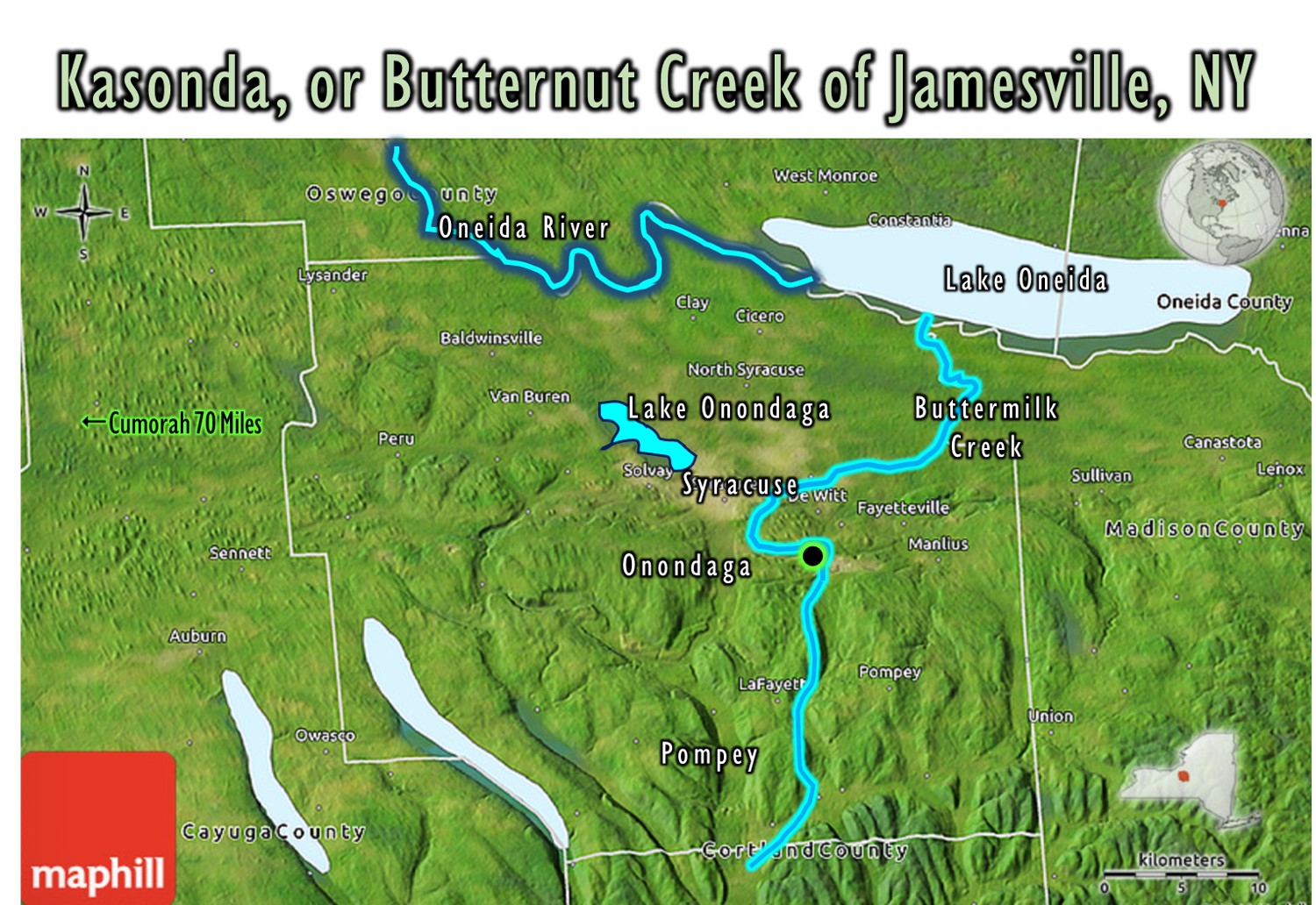
Posted By Judy On In Native American, New York
“The fact that the ruins of a square fort, with extensive sub-lines in the nature of an enclosure, had existed on the elevated grounds on the right banks of this stream, a mile or two from Jamesville, at the period of its first settlement, led me to visit it. There was the more interest imparted to this well attested tradition of the present inhabitants, by the accounts of the Onondagas, that this valley, in its extent above and below Jamesville, was one of their earliest points of settlement, prior to the era of their establishing their council fire at Onondaga Hollow. The subjoined sketch (below), although not plotted from actual measurement, will convey an idea of the relative position and former importance of the principal features, geographical and artificial, denoted. Indicates the site of the fort, which, at the time of my visit, was covered with a luxuriant field of wheat, without a feature to denote that it had ever been held under any other jurisdiction but that of the plough. The farm which embraces it, is owned and occupied by Isaac Keeler, who remarks that, at the time he came to settle here, the site of the old fort was an extensive opening in the forest, bearing grass, with some clumps of wild plumb trees, and a few forest trees. On this opening, the first regiment of militia that ever paraded in Onondaga county, met. It was commanded by Major De Witt, after whom the township is now named.
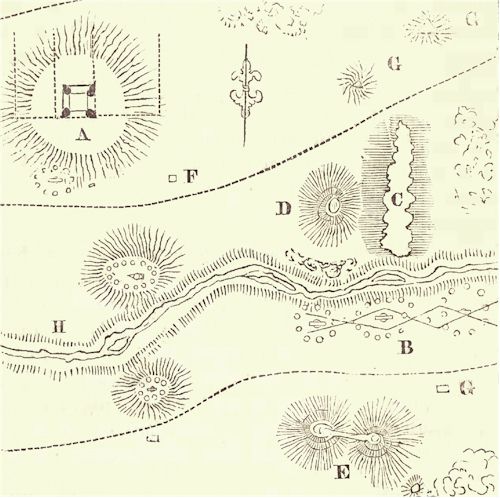
About the year 1810, he felled an oak, near the site of the fort, measuring two feet six inches in diameter. In recutting it for firewood, after it had been drawn to his door, a leaden bullet was found, covered by one hundred and forty-three cortical layers. From its position, embedded as it was in the compact wood, it was still some distance to the heart of the tree. He thinks this tree may have been a sapling when the bullet was fired. Whether this conjecture be true or not, one hundred and forty-three years appear to have elapsed since the bullet assumed its position. This would give A. D. 1667 as the era.
In 1666, the Governor of Canada concluded a treaty with the Onondaga Iroquois, as is seen from the “Paris Documents” obtained by Mr. Broadhead. Colden’s history of the Five Nations, which has been the principal source of information heretofore, after a brief summary of traditionary matter, 1 in the first chapter, opens with the transactions in 1665. This matter is more fully and satisfactorily stated by Charlevoix in his history of New France, from whom it is presumable, Golden drew his information of the former power and pre-eminence of the Adirondacks.
During this year De Traci came out as viceroy of New France, and the same year Monsieur Coursel, who is notorious for his perfidy in executing the Iroquois sachem, Agariata, arrived with the commission of Governor-General of Canada. But there is little to be found bearing directly on the subject before us.
It would appear from the journal of the Jesuit, Father Le Moyne 7 as given in the missionary “Relacions,” that the country of the Onondagas was not discovered and explored until the year 1653. Facts disclosed by him in the same letter denote, however, prior negotiations with the French authorities, and we are probably to understand only that as yet, no missionaries from his or any other order, had visited, or been established amongst this tribe. 2 In this view, and from the incidental light which he throws on some other topics, such as the new breaking out of the war with the Eries, the discovery of the salt springs, and the existence of the buffalo in the country, this letter is important to the early Iroquois history, and a translation of it is hereto appended. 3 It is certain that no mission or fort had then been introduced. A footing may, however, have been gained by the French within the next fourteen years, that is, at the time of the apparent date of the existence of the old fort on the right banks of the Kasonda.4
Where history fails, we may appeal to tradition and to the proofs drawn from antiquarian remains. Isaac Keeler, who is above mentioned, exhibited to me one-half of the brass circle of a dial plate, three inches (less two-tenths) in diameter, which had been ploughed up by him on the site of the fort, or from that general area. This circle had engraved, in good Roman characters, the numbers II, III, IV, V, VI, VII, VIII He likewise exhibited the box of a small brass pocket compass, with a screw lid one inch and two-tenths in diameter. From this instrument the needle had been removed and its place supplied by vermillion, the highly prized war pigment of the Indians. When plowed up and found at the bottom of a furrow, it was encrusted with oxide, but restored by washing and friction to its original color and even surface. On being opened, it was found to contain the pigment, of which I examined a portion. It appeared to me to have been, not the Chinese vermillion of the trade, but the duller red article, which is, I believe, a peroxide of lead prepared by the Dutch. 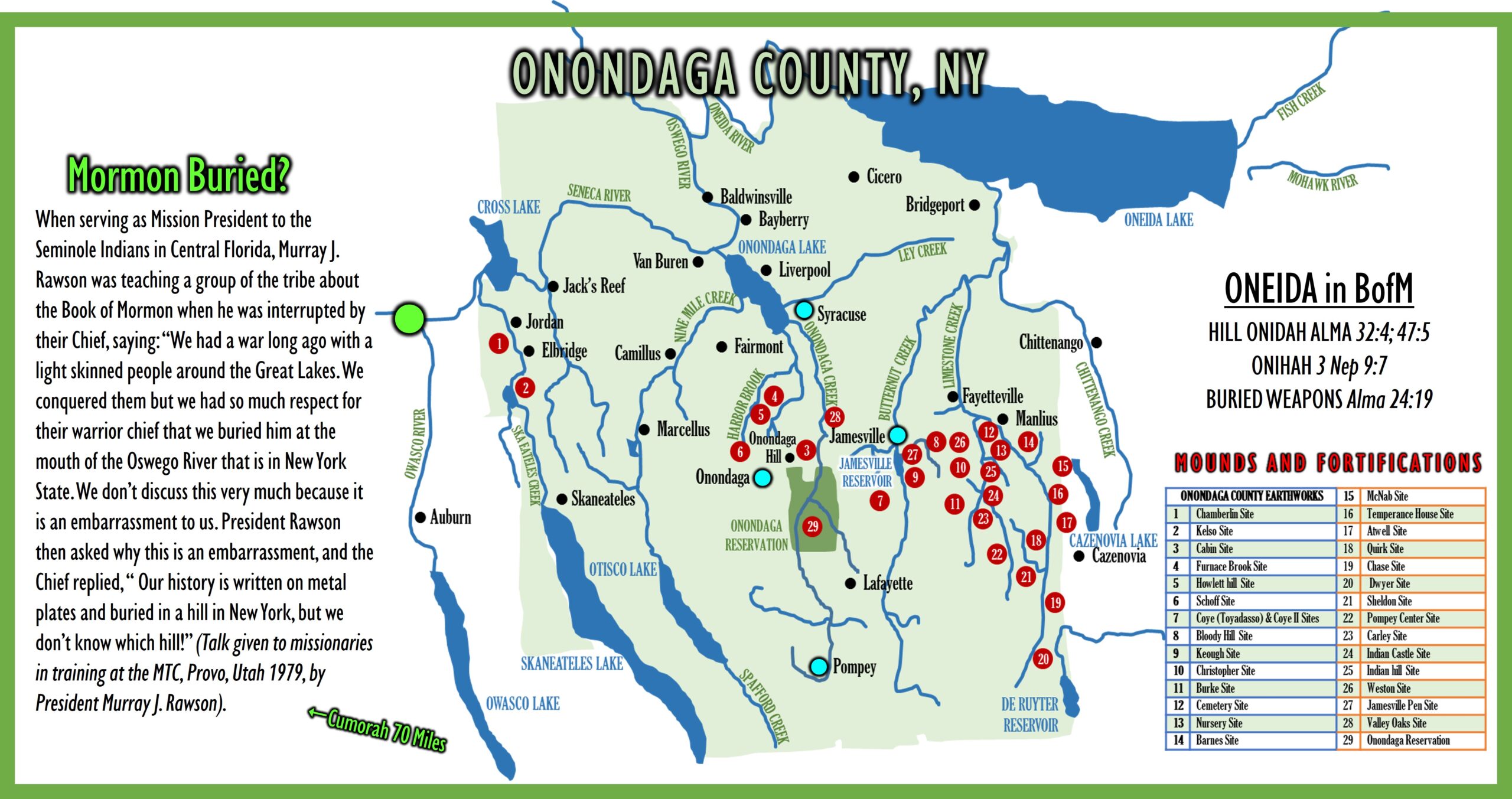
Among the articles which he had preserved were the following:
A crucifix of brass of two inches in length, ornamented by a human figure, and having a metallic loop for suspending it,
An octagonal medal, four-tenths of an inch, of the same material, bearing a figure with the name “St. Agatha,” and the Latin word “ora” a part of the Gregorian chant.
A similar medal, five-tenths of an inch in length, with a figure, Ascribed “St. Lucia,” and the same fragment of a chant.
A rude medal of lead, an inch and four-tenths long, ovate, with the figure of the Savior, as is supposed, being that of a person suspended by the outstretched hands, however, and the figure of a serpent, as if this form of temptation had been presented during his advent.
On the reverse, is a sitting figure, which bears most resemblance to a common and characteristic position of one of the native priests or prophets. Should this conjecture be correct, this figure may have been intended, adopting the Indian method, to teach the office of the Savior by a symbol. He is thus shown, however, to be merely the priest and prophet of men an idea which does not coincide with Catholic theology, and which, if not enlarged and corrected by verbal teaching, would convey no conception of his divine character and atonement, and thus leave the Onondaga neophyte essentially in the dark as before. To figure the Savior, as the great Josakeed of men, as is done in this medal, is indeed the most extraordinary and audacious act of which the history of missions among rude nations affords any parallel. The novelty of this feature in this apparently home wrought model, gives it a claim to be hereafter figured.
An iron horse-shoe, four and a half inches long nearly, and five inches, lacking two-tenths, broad, with three elongated nail holes in each side, and a clumsy steel cork, partially worn. The peculiar fabric of this shoe, its clumsiness and spread, and the little mechanical skill which it evinces in the hammering and general make, denote it to be very clearly the workmanship of a Canadian blacksmith, such as a rude Canadian blacksmith is still to be witnessed, in the lake country, and to have been, at the same time, intended for the unfarriered hoofs of the Canadian horse.
A pair of iron strap hinges, common and coarse. These my informant had turned to account, by employing them to hang the little gate which led, through a small flower plat, to his dwelling house. See figure F.
These articles have been selected for notice from many of more common occurrence, such as beads of coarse paste, enamel and glass, of various sizes and colors, which are evidently of European make. My informant further stated that a blacksmith s anvil, vice, horn, and almost every other article of a smith s shop, had been from time to time found on the site or in the vicinity, but there was nothing of this kind in his possession. On the south declivity of the hill, near the present road leading east to Pompey hill, there is a spring still sheltered with shrubbery, which he supposes furnished the fort with water. 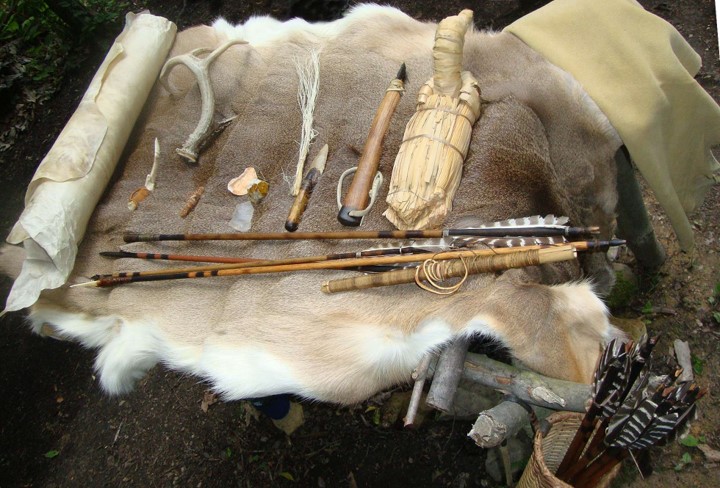
This fort constitutes but a part of the very marked evidences of former occupancy by man in a civilized state, and in a forgotten age, which occur in this portion of Onondaga, chiefly in the present towns of Pompey, Lafayette, Dewitt, Camillus and Manlius. For such of these evidences as did not pass under my personal notice, reference is made to letter C in the documentary appendix. Other observed localities and facts derived from other witnesses, illustrating the character of this fort, and of the ancient Indian settlements in the Kasonda valley, are marked H in the annexed sketch.
In this plat B denotes the site of an ancient Onondaga town or village, immediately on the banks of the stream, where water could be readily obtained for all purposes. C is the locality of the cemetery used at the period, on the ascending grounds on the north banks of the stream. It constitutes a well marked transverse ridge. Immediately west of it rises a natural mound, marked D, of large size, nearly conical in its shape, and terminating in a flat surface or plain, of an ovate border, some twelve by seventeen paces. James Gould, the proprietor of the land, who, from his residence, guided me to the spot, remarks that this conical hill, was formerly covered with a hard wood forest, similar in its species to those of the surrounding country, with the exception of a spot, some four or five paces diameter on its apex. This spot was, however, completely veiled from sight by the overtopping trees until the arcanum was entered. From the peculiar character of this eminence, and its relative position to the village and burial ground, it may be supposed to have been the site of the seers lodge, from which he uttered his sacred responses.
Speaking of the old fort of Kasonda, this informant remarked, that when he came into the country, its outlines could still be traced, that it was a square fort, with bastions, and had streets within it. It had been set round with cedar pickets, which had been burned to the ground. Stumps of these ancient palisades were struck by the plough. It is on this testimony, which at the same time, denotes a violent destruction of the work, that the geometrical figure of it, represented in A, is drawn. He had, I think, been in the revolution army, and drawn his bounty lands, as many of the original settlers on the military tract had done. He knew therefore, the import of the military terms he employed.
In a collection of aboriginal antiquarian articles at his house, he permitted me to make drawings of any taken from the fort grounds, or disinterred from ancient Indian graves, which appeared to me to merit it. Of these, but a few are pertinent to the present inquiry.
These are as follows:
Number 1, represents an antique collar or medal, (Nabikoágun,) wrought out of seashell. It is crossed with two parallel, and two horizontal lines, ornamented with dots, and dividing the surface into four equal parts. An orifice exists for introducing a string to suspend it about, the neck. This species of article, is found in Indian graves of the period preceding the discovery of the continent, or not extending more than one or two generations into the new period. It was probably an elegant ornament when bright and new, and exhibiting the natural color and natural of the shell. Inhumation has so far served to decompose the surface, as to coat it with a limy or chalky exterior, which effervesces in mineral acids. By scraping deep into it, the shelly structure is detected. This kind of ornament, varying much in size, was probably soon replaced by the metallic gorget and medal introduced by the trade, and has long been unknown both to Indians and traders. I found it first in Indian cemeteries of the west, without, however, for some time suspecting its real nature, supposing it some variety of altered pottery, or enamel paste; but have since traced it over the entire area of the ancient occupation of western New York, and, so far as examined, of Canada.
No. 2. A stone ring, one inch and two-tenths in diameter, made of a dark species of somewhat hard steatite or slaty rock. Its characteristic trait is found in its adaptation to the middle finger, (of a male) and its having eleven distinct radiating lines.
No. 3. A globular bead or amulet, [Minace,] of sea shell one inch and a half in diameter, solid and massy, having an orifice for suspending it. It is slightly ovate. Its structure from shell, is distinctly marked. Like the flat medal-shaped Nabikoágun (No. 1.) of the same material, it has a limy coating from the effects of partial decomposition. In the remaining features of the sketch, referred to, letters G. G., denote ancient remains of a European character in the contiguous part of the town of Pompey, which are more particularly described in the documentary appendix. 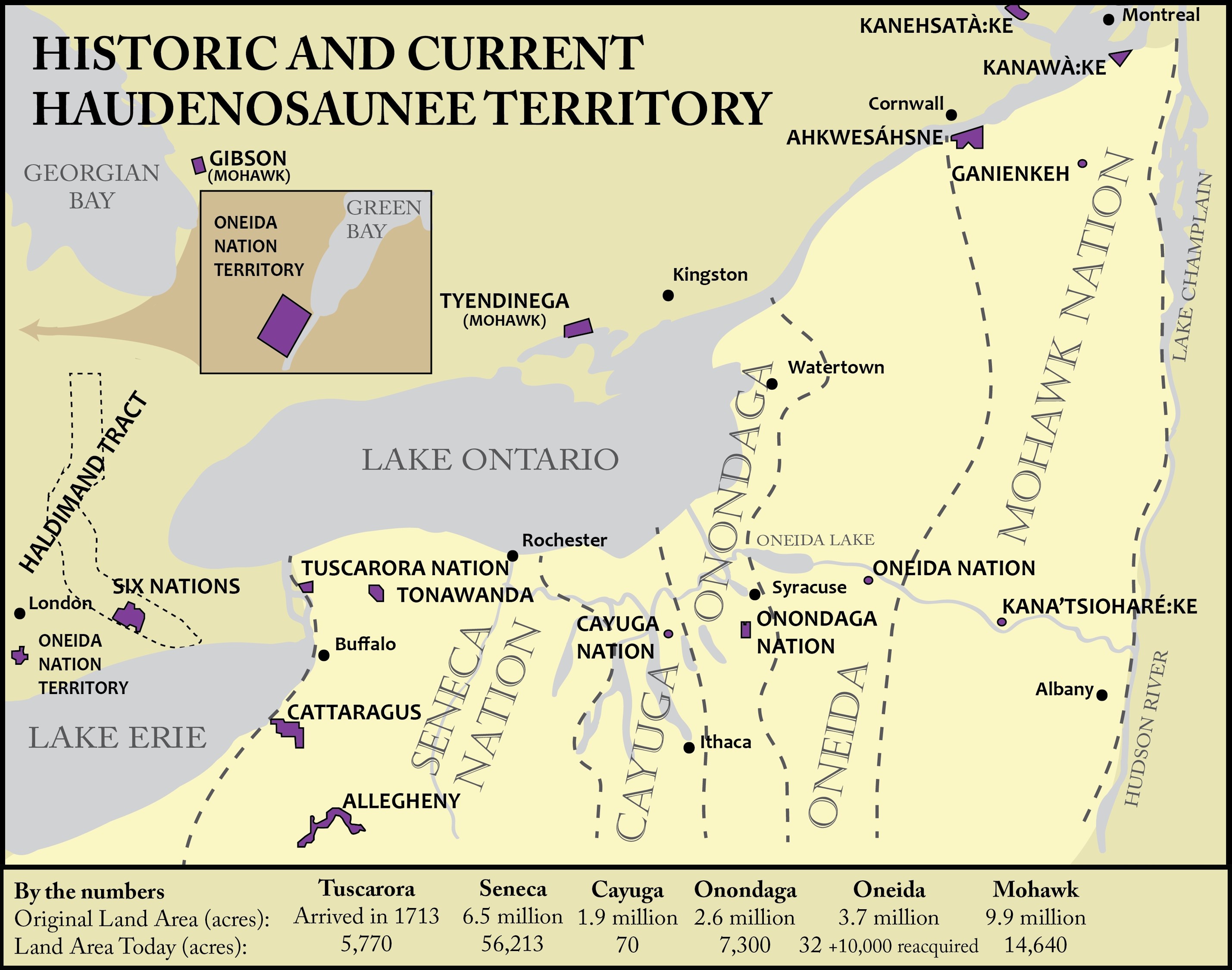
E Represents the Twin Mounds, two natural formations of fine gravel and other diluvial strata, situated on the south side of the creek, on the farm of Jeremiah Gould. These mounds are conspicuous features in the landscape, from their regularity, and position on elevated grounds, as well as from their connection with the ancient Indian history of the valley. These pyramidal heaps of earth are connected, by a neck of earth, in the manner represented. They exhibit the appearance of having been cleared of the forest, almost entirely, at an ancient date. The surface exhibits numerous pits or holes, which excite the idea of their having served as a noted locality for the Indian Assenjigun, or pit for hiding or putting en cache, corn or other articles, to preserve it from enemies, or as a place of deposit during temporary absences from the village. There can, I think, be little question that this was the true use and relation these geological eminences bore to the ancient town on the Kasonda, marked B. Such, too, is the general impression derived from local tradition. Some years ago, a skeleton was exhumed from one of these caches.
Footnotes
The States General of Holland surrendered New York to the English crown in 1664. ↩
That the Dutch traders had visited Onondaga at an earlier period is very probable. The Dutch had then been settled forty years at Albany. ↩
Vide chap. x., opriginal discovery of the Onondaga country. ↩
Firearms began to be first introduced among the Iroquois in 1609, the very year that Hudson explored the river now bearing his name. In this year, Champlain, heading the Algonquins, with some regular troops, in lake Corlear, (since called Champlain,) defeated the Mohawks by the use of firearms.” Article printed from Access Genealogy

